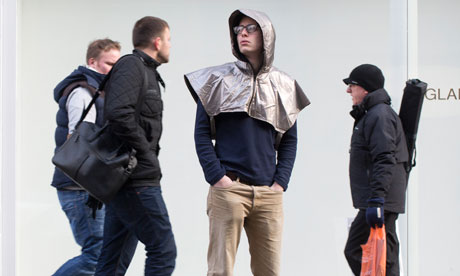Unmanned surveillance drones are a global concern, but designer Adam Harvey has concocted an outlandish solution Blending in? … The anti-drone hoodie, as modelled by Tom Meltzer, keeps surveillance off your back. Photograph: David Levene for the Guardian.
Blending in? … The anti-drone hoodie, as modelled by Tom Meltzer, keeps surveillance off your back. Photograph: David Levene for the Guardian.
I am wearing a silver hoodie that stops just below the nipples. Or, if you prefer, a baggy crop-top with a hood. The piece – this is fashion, so it has to be a “piece” – is one of a kind, a prototype. It has wide square shoulders and an overzealous zip that does up right to the tip of my nose.
It does not, it’s fair to say, make its wearer look especially cool. But that’s not really what this hoodie is about. It has been designed to hide me from the thermal imaging systems of unmanned aerial surveillance vehicles –drones. And, as far as I can tell, it’s working well.
“It’s what I call anti-drone,” explains designer Adam Harvey. “That’s the sentiment. The material in the anti-drone clothing is made of silver, which is reflective to heat and makes the wearer invisible to thermal imaging.”
The “anti-drone hoodie” was the central attraction of Harvey’s Stealth Wear exhibition, which opened in central London in January, billed as a showcase for “counter-surveillance fashions”. It is a field Harvey has been pioneering for three years now, making headlines in the tech community along the way.
It began in 2010 with Camoflash, an anti-paparazzi handbag that responds to the unwanted camera flashes with a counter-flash of its own, replacing the photograph’s intended subject with a fuzzy orb of bright white light.
Then came his thesis project CV Dazzle, a mix of bold makeup and hairstyling based on military camouflage techniques, designed to flummox computer face-recognition software. It worked, but also made you look like a cyberpunk with a face-painting addiction. Which was not exactly inconspicuous.
Once again, though, that wasn’t really the point. “These are primarily fashion items and art items,” Harvey tells me. “I’m not trying to make products for survivalists. I would like to introduce this idea to people: that surveillance is not bulletproof. That there are ways to interact with it and there are ways to aestheticise it.”
There is, I point out, no obvious target audience for anti-drone fashion. He’s unfazed. “The kind of person who would wear it really depends on what drones end up being used for. You can imagine everything, from general domestic spying by a government, or more commercial reconnaissance of individuals.” I suggest perhaps political protesters. “Yeah, sure. Maybe that’s the actual market.”
Harvey is well aware his work can seem a little before its time. “I wouldn’t say many people have a problem being imaged by drones yet,” he deadpans. “But it imagines that this is a problem and then presents a functional solution.”
Related
